CVC 21802: Right-of-Way at T-Intersections
CVC 21802 is a section of the California Vehicle Code (CVC) that outlines the rules and regulations regarding the right-of-way at T-intersections. This law is designed to establish the order in which vehicles should yield the right-of-way when approaching and navigating T-intersections, which are intersections where one road ends, forming a "T" shape with another road.
Here are the key points of CVC 21802:
-
Right-of-Way at T-Intersections: CVC 21802 specifies the rules for right-of-way at T-intersections. When two vehicles arrive at a T-intersection from different roadways or streets, the driver on the road that ends (the terminating road) is generally required to yield the right-of-way to the vehicles on the continuing road. In other words, the driver on the terminating road must allow the vehicles on the continuing road to proceed first.
-
Yield Signage: In some cases, yield signs may be posted at T-intersections to indicate which driver should yield the right-of-way. Drivers must obey these yield signs, and the vehicle that encounters the yield sign must yield to other vehicles as specified.
-
Uncontrolled T-Intersections: When a T-intersection is uncontrolled, meaning there are no stop signs or yield signs in place, CVC 21802 still applies. The driver on the terminating road must yield the right-of-way to vehicles on the continuing road.
-
Turning Left or Right: The law also specifies that if both drivers arrive at the intersection simultaneously, or if it's not possible to determine who arrived first, the driver on the terminating road must yield the right-of-way. This applies whether the driver on the continuing road intends to turn left or right.
-
Pedestrian Right-of-Way: CVC 21802 also emphasizes that drivers must yield the right-of-way to pedestrians lawfully crossing at the intersection.
-
Exemptions: There may be specific circumstances or local regulations that affect right-of-way rules at certain T-intersections. Drivers should always be attentive to road signs and pavement markings indicating right-of-way.
-
Penalties: Violations of CVC 21802 can result in legal consequences, including fines, and may also contribute to accidents and related liabilities.
Why CVC 21802 Matters:
CVC 21802 is significant for several reasons:
-
Safety: The law is designed to promote safe and orderly driving at T-intersections by establishing clear right-of-way rules, reducing the risk of accidents.
-
Traffic Flow: Following right-of-way rules contributes to the efficient flow of traffic and helps prevent congestion and conflicts at T-intersections.
-
Legal Compliance: Adhering to CVC 21802 is a legal obligation. Violating these regulations can result in penalties and potential legal consequences.
Penalties for Violation:
Penalties for violating CVC 21802 can vary depending on the specific circumstances, local jurisdiction, and the severity of the violation. Common consequences may include fines and potential points on a driver's record. More severe penalties may apply if a violation leads to an accident or endangers public safety.

DontPayTickets.com
Fight Back California Traffic Violations and Tickets

